+ Open data
Open data
- Basic information
Basic information
| Entry | Database: PDB / ID: 6tu3 | |||||||||
|---|---|---|---|---|---|---|---|---|---|---|
| Title | Rat 20S proteasome | |||||||||
 Components Components |
| |||||||||
 Keywords Keywords |  HYDROLASE / HYDROLASE /  PROTEASOME PROTEASOME | |||||||||
| Function / homology |  Function and homology information Function and homology informationCross-presentation of soluble exogenous antigens (endosomes) / SCF-beta-TrCP mediated degradation of Emi1 / Regulation of ornithine decarboxylase (ODC) / Assembly of the pre-replicative complex / GSK3B and BTRC:CUL1-mediated-degradation of NFE2L2 / Oxygen-dependent proline hydroxylation of Hypoxia-inducible Factor Alpha / Autodegradation of Cdh1 by Cdh1:APC/C / APC/C:Cdc20 mediated degradation of Securin / APC/C:Cdh1 mediated degradation of Cdc20 and other APC/C:Cdh1 targeted proteins in late mitosis/early G1 / Cdc20:Phospho-APC/C mediated degradation of Cyclin A ...Cross-presentation of soluble exogenous antigens (endosomes) / SCF-beta-TrCP mediated degradation of Emi1 / Regulation of ornithine decarboxylase (ODC) / Assembly of the pre-replicative complex / GSK3B and BTRC:CUL1-mediated-degradation of NFE2L2 / Oxygen-dependent proline hydroxylation of Hypoxia-inducible Factor Alpha / Autodegradation of Cdh1 by Cdh1:APC/C / APC/C:Cdc20 mediated degradation of Securin / APC/C:Cdh1 mediated degradation of Cdc20 and other APC/C:Cdh1 targeted proteins in late mitosis/early G1 / Cdc20:Phospho-APC/C mediated degradation of Cyclin A / SCF(Skp2)-mediated degradation of p27/p21 / Autodegradation of the E3 ubiquitin ligase COP1 / Asymmetric localization of PCP proteins / Degradation of DVL / Hedgehog ligand biogenesis / Dectin-1 mediated noncanonical NF-kB signaling / Degradation of GLI1 by the proteasome / Hedgehog 'on' state / TNFR2 non-canonical NF-kB pathway / NIK-->noncanonical NF-kB signaling / UCH proteinases / CDK-mediated phosphorylation and removal of Cdc6 / G2/M Checkpoints / Ubiquitin Mediated Degradation of Phosphorylated Cdc25A / Ubiquitin-dependent degradation of Cyclin D / The role of GTSE1 in G2/M progression after G2 checkpoint / FBXL7 down-regulates AURKA during mitotic entry and in early mitosis / RUNX1 regulates transcription of genes involved in differentiation of HSCs / Regulation of RUNX3 expression and activity / GLI3 is processed to GLI3R by the proteasome / Activation of NF-kappaB in B cells / Degradation of beta-catenin by the destruction complex / Degradation of AXIN / Regulation of RAS by GAPs / Orc1 removal from chromatin /  Neddylation / AUF1 (hnRNP D0) binds and destabilizes mRNA / MAPK6/MAPK4 signaling / Regulation of PTEN stability and activity / KEAP1-NFE2L2 pathway / Separation of Sister Chromatids / Antigen processing: Ubiquitination & Proteasome degradation / ABC-family proteins mediated transport / Ub-specific processing proteases / : / proteasome core complex / Neutrophil degranulation / Neddylation / AUF1 (hnRNP D0) binds and destabilizes mRNA / MAPK6/MAPK4 signaling / Regulation of PTEN stability and activity / KEAP1-NFE2L2 pathway / Separation of Sister Chromatids / Antigen processing: Ubiquitination & Proteasome degradation / ABC-family proteins mediated transport / Ub-specific processing proteases / : / proteasome core complex / Neutrophil degranulation /  immune system process / immune system process /  myofibril / myofibril /  NF-kappaB binding / NF-kappaB binding /  proteasome endopeptidase complex / proteasome core complex, beta-subunit complex / proteasome core complex, alpha-subunit complex / threonine-type endopeptidase activity / negative regulation of inflammatory response to antigenic stimulus / response to organonitrogen compound / proteasome endopeptidase complex / proteasome core complex, beta-subunit complex / proteasome core complex, alpha-subunit complex / threonine-type endopeptidase activity / negative regulation of inflammatory response to antigenic stimulus / response to organonitrogen compound /  proteasome complex / proteolysis involved in protein catabolic process / proteasome complex / proteolysis involved in protein catabolic process /  sarcomere / ciliary basal body / proteasomal protein catabolic process / sarcomere / ciliary basal body / proteasomal protein catabolic process /  P-body / P-body /  lipopolysaccharide binding / response to virus / response to organic cyclic compound / lipopolysaccharide binding / response to virus / response to organic cyclic compound /  nuclear matrix / positive regulation of NF-kappaB transcription factor activity / nuclear matrix / positive regulation of NF-kappaB transcription factor activity /  peptidase activity / ubiquitin-dependent protein catabolic process / postsynapse / proteasome-mediated ubiquitin-dependent protein catabolic process / peptidase activity / ubiquitin-dependent protein catabolic process / postsynapse / proteasome-mediated ubiquitin-dependent protein catabolic process /  endopeptidase activity / response to oxidative stress / endopeptidase activity / response to oxidative stress /  ribosome / ribosome /  centrosome / centrosome /  synapse / synapse /  ubiquitin protein ligase binding / ubiquitin protein ligase binding /  proteolysis / proteolysis /  RNA binding / RNA binding /  nucleoplasm / identical protein binding / nucleoplasm / identical protein binding /  nucleus / nucleus /  cytosol / cytosol /  cytoplasm cytoplasmSimilarity search - Function | |||||||||
| Biological species |   Rattus norvegicus (Norway rat) Rattus norvegicus (Norway rat) | |||||||||
| Method |  ELECTRON MICROSCOPY / ELECTRON MICROSCOPY /  single particle reconstruction / single particle reconstruction /  cryo EM / Resolution: 2.7 Å cryo EM / Resolution: 2.7 Å | |||||||||
 Authors Authors | Deshmukh, F.K. / Polkinghorn, C.R. / Elad, N. / Sharon, M. | |||||||||
| Funding support |  Israel, 2items Israel, 2items
| |||||||||
 Citation Citation |  Journal: ACS Cent Sci / Year: 2020 Journal: ACS Cent Sci / Year: 2020Title: Comparative Structural Analysis of 20S Proteasome Ortholog Protein Complexes by Native Mass Spectrometry. Authors: Shay Vimer / Gili Ben-Nissan / David Morgenstern / Fanindra Kumar-Deshmukh / Caley Polkinghorn / Royston S Quintyn / Yury V Vasil'ev / Joseph S Beckman / Nadav Elad / Vicki H Wysocki / Michal Sharon /   Abstract: Ortholog protein complexes are responsible for equivalent functions in different organisms. However, during evolution, each organism adapts to meet its physiological needs and the environmental ...Ortholog protein complexes are responsible for equivalent functions in different organisms. However, during evolution, each organism adapts to meet its physiological needs and the environmental challenges imposed by its niche. This selection pressure leads to structural diversity in protein complexes, which are often difficult to specify, especially in the absence of high-resolution structures. Here, we describe a multilevel experimental approach based on native mass spectrometry (MS) tools for elucidating the structural preservation and variations among highly related protein complexes. The 20S proteasome, an essential protein degradation machinery, served as our model system, wherein we examined five complexes isolated from different organisms. We show that throughout evolution, from the archaeal prokaryotic complex to the eukaryotic 20S proteasomes in yeast () and mammals (rat - , rabbit - and human - HEK293 cells), the proteasome increased both in size and stability. Native MS structural signatures of the rat and rabbit 20S proteasomes, which heretofore lacked high-resolution, three-dimensional structures, highly resembled that of the human complex. Using cryoelectron microscopy single-particle analysis, we were able to obtain a high-resolution structure of the rat 20S proteasome, allowing us to validate the MS-based results. Our study also revealed that the yeast complex, and not those in mammals, was the largest in size and displayed the greatest degree of kinetic stability. Moreover, we also identified a new proteoform of the PSMA7 subunit that resides within the rat and rabbit complexes, which to our knowledge have not been previously described. Altogether, our strategy enables elucidation of the unique structural properties of protein complexes that are highly similar to one another, a framework that is valid not only to ortholog protein complexes, but also for other highly related protein assemblies. | |||||||||
| History |
|
- Structure visualization
Structure visualization
| Movie |
 Movie viewer Movie viewer |
|---|---|
| Structure viewer | Molecule:  Molmil Molmil Jmol/JSmol Jmol/JSmol |
- Downloads & links
Downloads & links
- Download
Download
| PDBx/mmCIF format |  6tu3.cif.gz 6tu3.cif.gz | 1 MB | Display |  PDBx/mmCIF format PDBx/mmCIF format |
|---|---|---|---|---|
| PDB format |  pdb6tu3.ent.gz pdb6tu3.ent.gz | 862 KB | Display |  PDB format PDB format |
| PDBx/mmJSON format |  6tu3.json.gz 6tu3.json.gz | Tree view |  PDBx/mmJSON format PDBx/mmJSON format | |
| Others |  Other downloads Other downloads |
-Validation report
| Arichive directory |  https://data.pdbj.org/pub/pdb/validation_reports/tu/6tu3 https://data.pdbj.org/pub/pdb/validation_reports/tu/6tu3 ftp://data.pdbj.org/pub/pdb/validation_reports/tu/6tu3 ftp://data.pdbj.org/pub/pdb/validation_reports/tu/6tu3 | HTTPS FTP |
|---|
-Related structure data
| Related structure data |  10586MC M: map data used to model this data C: citing same article ( |
|---|---|
| Similar structure data |
- Links
Links
- Assembly
Assembly
| Deposited unit | 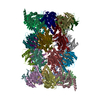
|
|---|---|
| 1 |
|
- Components
Components
-Proteasome subunit alpha type- ... , 7 types, 14 molecules AOBPCQDRESFTGU
| #1: Protein |  / Macropain iota chain / Multicatalytic endopeptidase complex iota chain / Proteasome iota chain / Macropain iota chain / Multicatalytic endopeptidase complex iota chain / Proteasome iota chainMass: 27432.459 Da / Num. of mol.: 2 / Source method: isolated from a natural source / Source: (natural)   Rattus norvegicus (Norway rat) Rattus norvegicus (Norway rat)References: UniProt: P60901,  proteasome endopeptidase complex proteasome endopeptidase complex#2: Protein |  / Macropain subunit C3 / Multicatalytic endopeptidase complex subunit C3 / Proteasome component C3 / Macropain subunit C3 / Multicatalytic endopeptidase complex subunit C3 / Proteasome component C3Mass: 25955.549 Da / Num. of mol.: 2 / Source method: isolated from a natural source / Source: (natural)   Rattus norvegicus (Norway rat) Rattus norvegicus (Norway rat)References: UniProt: P17220,  proteasome endopeptidase complex proteasome endopeptidase complex#3: Protein |  / Macropain subunit C9 / Multicatalytic endopeptidase complex subunit C9 / Proteasome component C9 / ...Macropain subunit C9 / Multicatalytic endopeptidase complex subunit C9 / Proteasome component C9 / Proteasome subunit L / Macropain subunit C9 / Multicatalytic endopeptidase complex subunit C9 / Proteasome component C9 / ...Macropain subunit C9 / Multicatalytic endopeptidase complex subunit C9 / Proteasome component C9 / Proteasome subunit LMass: 29539.830 Da / Num. of mol.: 2 / Source method: isolated from a natural source / Source: (natural)   Rattus norvegicus (Norway rat) Rattus norvegicus (Norway rat)References: UniProt: P21670,  proteasome endopeptidase complex proteasome endopeptidase complex#4: Protein |  / Proteasome subunit RC6-1 / Proteasome subunit RC6-1Mass: 28369.439 Da / Num. of mol.: 2 / Source method: isolated from a natural source / Source: (natural)   Rattus norvegicus (Norway rat) Rattus norvegicus (Norway rat)References: UniProt: P48004,  proteasome endopeptidase complex proteasome endopeptidase complex#5: Protein |  / Macropain zeta chain / Multicatalytic endopeptidase complex zeta chain / Proteasome zeta chain / Macropain zeta chain / Multicatalytic endopeptidase complex zeta chain / Proteasome zeta chainMass: 26416.850 Da / Num. of mol.: 2 / Source method: isolated from a natural source / Source: (natural)   Rattus norvegicus (Norway rat) Rattus norvegicus (Norway rat)References: UniProt: P34064,  proteasome endopeptidase complex proteasome endopeptidase complex#6: Protein |  / Macropain subunit C2 / Multicatalytic endopeptidase complex subunit C2 / Proteasome component C2 / ...Macropain subunit C2 / Multicatalytic endopeptidase complex subunit C2 / Proteasome component C2 / Proteasome nu chain / Macropain subunit C2 / Multicatalytic endopeptidase complex subunit C2 / Proteasome component C2 / ...Macropain subunit C2 / Multicatalytic endopeptidase complex subunit C2 / Proteasome component C2 / Proteasome nu chainMass: 29557.541 Da / Num. of mol.: 2 / Source method: isolated from a natural source / Source: (natural)   Rattus norvegicus (Norway rat) Rattus norvegicus (Norway rat)References: UniProt: P18420,  proteasome endopeptidase complex proteasome endopeptidase complex#7: Protein |  / Macropain subunit C8 / Multicatalytic endopeptidase complex subunit C8 / Proteasome component C8 / ...Macropain subunit C8 / Multicatalytic endopeptidase complex subunit C8 / Proteasome component C8 / Proteasome subunit K / Macropain subunit C8 / Multicatalytic endopeptidase complex subunit C8 / Proteasome component C8 / ...Macropain subunit C8 / Multicatalytic endopeptidase complex subunit C8 / Proteasome component C8 / Proteasome subunit KMass: 28456.275 Da / Num. of mol.: 2 / Source method: isolated from a natural source / Source: (natural)   Rattus norvegicus (Norway rat) Rattus norvegicus (Norway rat)References: UniProt: P18422,  proteasome endopeptidase complex proteasome endopeptidase complex |
|---|
-Proteasome subunit beta type- ... , 7 types, 14 molecules HVIWJXKYLZMaNb
| #8: Protein |  / Macropain delta chain / Multicatalytic endopeptidase complex delta chain / Proteasome chain 5 / ...Macropain delta chain / Multicatalytic endopeptidase complex delta chain / Proteasome chain 5 / Proteasome delta chain / Proteasome subunit Y / Macropain delta chain / Multicatalytic endopeptidase complex delta chain / Proteasome chain 5 / ...Macropain delta chain / Multicatalytic endopeptidase complex delta chain / Proteasome chain 5 / Proteasome delta chain / Proteasome subunit YMass: 25309.576 Da / Num. of mol.: 2 / Source method: isolated from a natural source / Source: (natural)   Rattus norvegicus (Norway rat) Rattus norvegicus (Norway rat)References: UniProt: P28073,  proteasome endopeptidase complex proteasome endopeptidase complex#9: Protein |  / Macropain chain Z / Multicatalytic endopeptidase complex chain Z / Proteasome subunit Z / Macropain chain Z / Multicatalytic endopeptidase complex chain Z / Proteasome subunit ZMass: 29963.461 Da / Num. of mol.: 2 / Source method: isolated from a natural source / Source: (natural)   Rattus norvegicus (Norway rat) Rattus norvegicus (Norway rat)References: UniProt: Q9JHW0,  proteasome endopeptidase complex proteasome endopeptidase complex#10: Protein |  PSMB3 / Proteasome chain 13 / Proteasome component C10-II / Proteasome theta chain PSMB3 / Proteasome chain 13 / Proteasome component C10-II / Proteasome theta chainMass: 22988.895 Da / Num. of mol.: 2 / Source method: isolated from a natural source / Source: (natural)   Rattus norvegicus (Norway rat) Rattus norvegicus (Norway rat)References: UniProt: P40112,  proteasome endopeptidase complex proteasome endopeptidase complex#11: Protein |  PSMB2 / Macropain subunit C7-I / Multicatalytic endopeptidase complex subunit C7-I / Proteasome component C7-I PSMB2 / Macropain subunit C7-I / Multicatalytic endopeptidase complex subunit C7-I / Proteasome component C7-IMass: 22941.381 Da / Num. of mol.: 2 / Source method: isolated from a natural source / Source: (natural)   Rattus norvegicus (Norway rat) Rattus norvegicus (Norway rat)References: UniProt: P40307,  proteasome endopeptidase complex proteasome endopeptidase complex#12: Protein |  PSMB5 / Macropain epsilon chain / Multicatalytic endopeptidase complex epsilon chain / Proteasome chain 6 / ...Macropain epsilon chain / Multicatalytic endopeptidase complex epsilon chain / Proteasome chain 6 / Proteasome epsilon chain / Proteasome subunit X PSMB5 / Macropain epsilon chain / Multicatalytic endopeptidase complex epsilon chain / Proteasome chain 6 / ...Macropain epsilon chain / Multicatalytic endopeptidase complex epsilon chain / Proteasome chain 6 / Proteasome epsilon chain / Proteasome subunit XMass: 28615.408 Da / Num. of mol.: 2 / Source method: isolated from a natural source / Source: (natural)   Rattus norvegicus (Norway rat) Rattus norvegicus (Norway rat)References: UniProt: P28075,  proteasome endopeptidase complex proteasome endopeptidase complex#13: Protein |  PSMB1 / Macropain subunit C5 / Multicatalytic endopeptidase complex subunit C5 / Proteasome component C5 / ...Macropain subunit C5 / Multicatalytic endopeptidase complex subunit C5 / Proteasome component C5 / Proteasome gamma chain PSMB1 / Macropain subunit C5 / Multicatalytic endopeptidase complex subunit C5 / Proteasome component C5 / ...Macropain subunit C5 / Multicatalytic endopeptidase complex subunit C5 / Proteasome component C5 / Proteasome gamma chainMass: 26511.301 Da / Num. of mol.: 2 / Source method: isolated from a natural source / Source: (natural)   Rattus norvegicus (Norway rat) Rattus norvegicus (Norway rat)References: UniProt: P18421,  proteasome endopeptidase complex proteasome endopeptidase complex#14: Protein |  PSMB4 / Macropain beta chain / Multicatalytic endopeptidase complex beta chain / Proteasome beta chain / ...Macropain beta chain / Multicatalytic endopeptidase complex beta chain / Proteasome beta chain / Proteasome chain 3 / RN3 PSMB4 / Macropain beta chain / Multicatalytic endopeptidase complex beta chain / Proteasome beta chain / ...Macropain beta chain / Multicatalytic endopeptidase complex beta chain / Proteasome beta chain / Proteasome chain 3 / RN3Mass: 29226.248 Da / Num. of mol.: 2 / Source method: isolated from a natural source / Source: (natural)   Rattus norvegicus (Norway rat) Rattus norvegicus (Norway rat)References: UniProt: P34067,  proteasome endopeptidase complex proteasome endopeptidase complex |
|---|
-Experimental details
-Experiment
| Experiment | Method:  ELECTRON MICROSCOPY ELECTRON MICROSCOPY |
|---|---|
| EM experiment | Aggregation state: PARTICLE / 3D reconstruction method:  single particle reconstruction single particle reconstruction |
- Sample preparation
Sample preparation
| Component | Name: Rat liver 20S proteasome / Type: COMPLEX Details: Endogenous 20S proteasome purified from the rat livers by anion-exchange chromatography Entity ID: all / Source: NATURAL |
|---|---|
| Source (natural) | Organism:   Rattus norvegicus (Norway rat) Rattus norvegicus (Norway rat) |
| Buffer solution | pH: 7.4 |
| Buffer component | Conc.: 160 mM / Name: Potassium phosphate / Formula: K3PO4 |
| Specimen | Conc.: 14 mg/ml / Embedding applied: NO / Shadowing applied: NO / Staining applied : NO / Vitrification applied : NO / Vitrification applied : YES / Details: Purified endogenous rat liver 20S proteasome : YES / Details: Purified endogenous rat liver 20S proteasome |
| Specimen support | Details: Grids were glow discharged 30 minutes before applying the sample. Grid material: COPPER / Grid mesh size: 300 divisions/in. / Grid type: C-flat-2/2 |
Vitrification | Instrument: FEI VITROBOT MARK IV / Cryogen name: ETHANE / Humidity: 100 % / Chamber temperature: 277 K / Details: blot for 3 seconds |
- Electron microscopy imaging
Electron microscopy imaging
| Experimental equipment |  Model: Titan Krios / Image courtesy: FEI Company |
|---|---|
| Microscopy | Model: FEI TITAN KRIOS Details: Preliminary grid screening was performed on Talos Arctica |
| Electron gun | Electron source : :  FIELD EMISSION GUN / Accelerating voltage: 300 kV / Illumination mode: OTHER FIELD EMISSION GUN / Accelerating voltage: 300 kV / Illumination mode: OTHER |
| Electron lens | Mode: DIFFRACTION / Nominal magnification: 105000 X / Nominal defocus max: 1600 nm / Nominal defocus min: 600 nm / Cs / Nominal magnification: 105000 X / Nominal defocus max: 1600 nm / Nominal defocus min: 600 nm / Cs : 2.7 mm / C2 aperture diameter: 70 µm : 2.7 mm / C2 aperture diameter: 70 µm |
| Specimen holder | Cryogen: NITROGEN / Specimen holder model: FEI TITAN KRIOS AUTOGRID HOLDER |
| Image recording | Average exposure time: 1.5 sec. / Electron dose: 37 e/Å2 / Film or detector model: GATAN K3 BIOQUANTUM (6k x 4k) / Num. of grids imaged: 1 / Num. of real images: 2234 Details: Images were collected in movie-mode at 45 frames per second |
| EM imaging optics | Energyfilter name : GIF Bioquantum / Energyfilter slit width: 20 eV : GIF Bioquantum / Energyfilter slit width: 20 eV |
- Processing
Processing
| EM software |
| ||||||||||||||||||||||||||||
|---|---|---|---|---|---|---|---|---|---|---|---|---|---|---|---|---|---|---|---|---|---|---|---|---|---|---|---|---|---|
CTF correction | Type: PHASE FLIPPING AND AMPLITUDE CORRECTION | ||||||||||||||||||||||||||||
| Particle selection | Num. of particles selected: 284161 | ||||||||||||||||||||||||||||
| Symmetry | Point symmetry : C2 (2 fold cyclic : C2 (2 fold cyclic ) ) | ||||||||||||||||||||||||||||
3D reconstruction | Resolution: 2.7 Å / Resolution method: FSC 0.143 CUT-OFF / Num. of particles: 245800 / Algorithm: BACK PROJECTION / Symmetry type: POINT | ||||||||||||||||||||||||||||
| Atomic model building | Protocol: FLEXIBLE FIT |
 Movie
Movie Controller
Controller



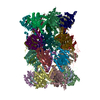
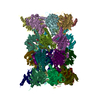

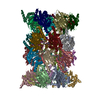
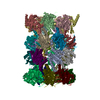
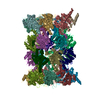
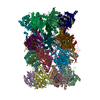



 PDBj
PDBj










